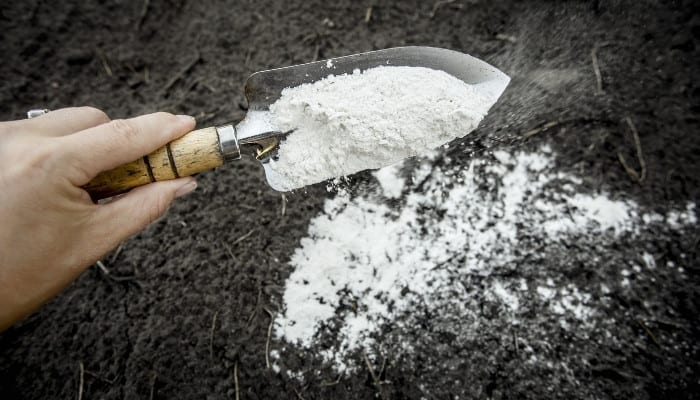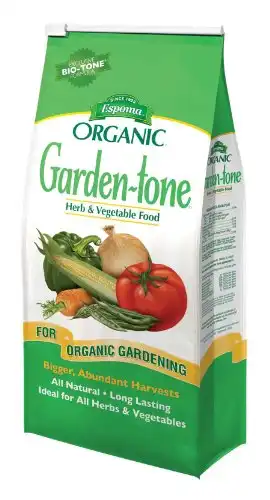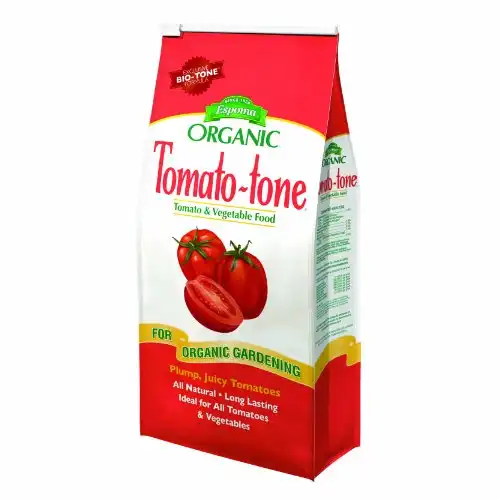As horticulturists, we have an innate desire to provide our plants with the best care possible. Along with meticulously planned watering routines and frequent pest checks, fertilizer is a crucial component.
It replaces necessary nutrients and encourages vigorous growth, better blooms, and healthy fruit. One question all plant people eventually wonder: Are all fertilizers about the same?
However, the answer isn’t always clear-cut. This article discusses the benefits, similarities, and differences between Garden-Tone and Tomato-Tone.
What’s the difference between Garden-tone and Tomato-tone? Both Garden-tone and Tomato-tone are natural organic plant foods. Garden-tone is suitable for vegetables and herbs, while Tomato-tone is beneficial for all varieties of tomato plants but can also be used for peppers and squash. Tomato-tone contains higher levels of calcium, potash, and sulphur.
Let’s take a closer look at exactly how garden-tone and tomato tone stack up against each other.
Garden Tone vs. Tomato Tone
With great products like Garden-tone and Tomato-tone on the market, it can be hard to decide which one to use.
Both are considered natural plant food that increases crop yield and promotes vigorous growth. Knowing which to use is the key to a garden of abundance.
| Product Specifications | Garden Tone | Tomato Tone |
| Ingredients | 3% Water-soluble nitrogen
4% Phosphate 4% Potash 5% Calcium 1% Magnesium 2% Sulphur |
3% Water-soluble nitrogen
4% Phosphate 6% Potash 8% Calcium 1% Magnesium 3% Sulphur |
| Uses | Herbs and vegetables
Hardy cool-season crops Semi-hardy spring & autumn crops Summer crops * Can be used on tomatoes |
All varieties of tomatoes
Peppers Squash Melons |
| When to Apply | Add to soil prior to planting.
Feed seedlings 7-10 days after planting. Use once monthly in the growing season. |
Add to soil prior to planting.
Feed new plants 10-14 days after planting. Use twice monthly during the growing season. |
Garden Tone
Garden-tone is a natural, organic plant food suitable for herbs and vegetables. While made from organic plant products, some products contain non-plant food ingredients.
If you prefer a fully organic product, check the label to ensure it is entirely organic.
Formulation
Garden-tone has a formulation of 3-4-4 NPK (Nitrogen, Phosphorus, Potassium) and is derived from a range of by-products, including alfalfa meal, poultry manure, bone meal, greensand, sulphate of potash, and magnesia.
This formulation contains 2.2% of slow-release nitrogen.
Applications
Garden-tone is initially applied to the soil prior to planting and then re-applied throughout the growing season. Each application differs in measurement and depends on your plants’ growing environment.
Soil preparation prior to planting
- Planting vegetables in soil: Mix 3.5 pounds with equal parts compost, humus, or peat, per 50 square feet of soil.
- Potting vegetables: Measure 2 cups of Garden-tone per cubic foot of fresh potting mix.
- Planting herbs in soil: Use 1 tablespoon per herb plug.
Fertilizing established vegetables and herbs
- Established plants grown in soil: Measure ⅓ cup of Garden-tone per plant.
- Plants grown in rows: 10 pounds applied to each side of the row per 100 feet.
- Potted plants: Measure 1.5 teaspoons per 4-inch container.
- Potted herbs: ½ tablespoon per plant.
When and How To Apply
Garden-tone is applied to the soil prior to planting to enhance the condition. This provides your new plants with an excellent nutritional start to the season.
It is then re-applied 7 to 10 days after planting, providing a boost to the established plants. Additional applications are made once monthly to keep plants thriving and producing healthy fruit.
Preparation
Preparing soil for planting:
Turn the soil over, removing weeds and debris from the previous growing season.
Consider the size of the garden, then apply 3.5 pounds of Garden-tone per 50 square feet of soil, working it into the top 6 inches of soil.
For added nutrients and improved drainage, mix in equal parts of compost, peat moss, or humus.
Preparing soil for pot plants and herbs:
Measure two cups of Garden-tone per cubic foot of potting mix. Thoroughly mix into the soil, and then fill each container.
Feeding
Plants in soil:
Seedlings should receive a booster application of Garden-tone approximately 7-10 days after being planted into the soil.
Established plants require feeding once monthly to replenish the soil’s nutrients in the growing season. Sprinkle ⅓ cup of Garden-tone around the base of singular plants.
For row-grown plants, use 10 pounds per 100 feet of row – spread evenly on either side of the row, and water thoroughly.
Potted plants:
Measure out 1.5 teaspoons of Garden-tone per 4-inch pot and carefully sprinkle around the base of the plant, steering clear of the stem and foliage. Then water thoroughly.
* Note: Herbs only require feeding when they are first planted and after a large harvest.
Does Garden Tone Burn Plants?
While Garden-tone is considered a slow-release fertilizer and therefore less likely to cause fertilizer burn, it is advised to follow the application instructions.
Too much fertilizer can cause scorching of foliage and roots. The symptoms include yellow or brown foliage and root damage.
Can You Use Too Much Garden Tone?
It is indeed possible to use too much Garden-tone, and the effects will be detrimental.
Follow the instructions found on the Garden-tone packaging to ensure you don’t overdose your plants, resulting in fertilizer burn.
Does Garden Tone Expire?
Garden-tone doesn’t expire because it contains minerals such as nitrogen, phosphorus, and potassium, which don’t break down over time. A package should remain useable for many years if stored properly.
Tomato Tone
Tomato tone is an organic plant feed suitable for all tomato plant varieties and certain fruit-producing crops. Squash, melon, and peppers also benefit from applications of Tomato-tone.
A particular benefit of Tomato-tone is its high calcium content, which helps prevent blossom end rot in susceptible crops.
Formulation
Tomato-tone has a formulation of 3-4-6 NPK (Nitrogen, Phosphorus, Potassium) and is derived from feather meal, alfalfa meal, greensand, sulphate of potash and magnesia, bone meal, and poultry manure.
This formulation contains 2.1% of slow-release nitrogen – slightly lower than Garden-tone.
Applications
Soil preparation for tomato beds and pots
- Tomatoes in soil: Apply 9 cups of tomato tone per 50 square feet of soil.
- Single tomato plants planted in soil: Measure 3 tablespoons of tomato-tone and mix into the soil when planting.
- Potted tomato plants: Use 1.5 tablespoons of Tomato-tone per 1 quart of soil or mix 2 cups of Tomato-tone per cubic foot of potting soil.
Fertilizing established tomatoes in beds and pots
- Established plants grown in soil: Spread 1 cup of tomato tone per 5 feet of row (either side).
- Single plants: Apply 3 tablespoons per plant.
- Potted plants: Apply 1.5 tablespoons per 12-inch container or 1.5 teaspoons per 4-inch container.
When and How To Apply
Tomato-tone is applied more regularly than Garden-tone because the tomato plant requires additional nutrients to support its vigorous growth.
Tomato-tone is applied to the soil before planting the seedlings to improve nutrient content.
It is then re-applied 10-14 days later to provide additional support for the hungry seedlings and then twice monthly during the growing season to maintain the soil’s nutrient content.
Preparation
Preparing soil for planting:
Once the soil has been cleared of debris and dug over, apply 9 cups of Tomato-tone per 50 square feet of soil.
Using a trowel, work the Tomato-tone into the first 6 inches of soil. Then plant the tomato seedlings, spaced evenly in rows, and water thoroughly.
Preparing soil for containers:
Select a suitably sized container as tomato plants can get quite large, and mix two cups of Tomato-tone per cubic foot of potting soil.
For smaller containers, mix one quart soil with 1.5 tablespoons of Tomato-tone, and mix thoroughly. Then plant the seedlings, and water thoroughly.
Feeding
Plants in soil:
Seedlings should receive a booster feeding of Tomato-tone once planted for 10-14 days.
Once established, a regular feeding schedule of every two weeks should then commence and be continued throughout the growing season.
Apply one cup of Tomato-tone on either side of the tomato plant rows, keeping at least a 3-inch distance between the fertilizer and the plant.
For single plants, apply 3 tablespoons per plant in a thin band around the base.
Plants in containers
Use 1.5 teaspoons of Tomato-tone per 4-inch container and spread evenly over the soil. Mix in gently, and water thoroughly.
For larger pots, increase the dosage to 1.5 tablesp00ns per 12-inch container.
Will Tomato Tone Burn Plants?
While some say that Tomato-tone won’t burn plants, excessive fertilizing can affect plants in other ways.
Fertilizer contains nitrogen, resulting in lush foliage when applied excessively, but it can also impede flower and fruit development.
Can You Use Too Much Tomato Tone?
Following the application instructions on the packaging is advised for healthy plant growth.
However, because Tomato-tone is a slow-release fertilizer, slightly excessive amounts given to healthy plants won’t cause harm but may impede crop yield.
Can You Use Tomato Tone on Other Plants?
Tomato-tone is also beneficial for other fruiting plants such as peppers, melons, and squash.
The higher calcium levels are excellent for crops that are susceptible to blossom end rot. This disease is caused by calcium deficiency and causes dark leathery spots on fruit or deformed fruit.
How Garden Tone and Tomato Tone Differ From Other Fertilizers
Both Garden-tone and Tomato-tone are made from natural ingredients (plant matter and poultry manure).
These organic fertilizers release nutrients into the soil as they break down, thus improving soil structure, moisture, and nutrient retention.
In addition, they are less likely to cause fertilizer burn due to their slow-release properties. Both products are eco-friendly and biodegradable, unlike other fertilizers, which are chemical-based.
Are Garden Tone and Tomato Tone Interchangeable?
Certain plants will benefit from using either Tomato-tone or Garden-tone; however, it’s advised to use the right fertilizer for your plants to achieve the best results.
For example, using Garden-tone in place of Tomato-tone on your tomato plants may be beneficial, but it won’t be as effective.
In addition, using Tomato-tone on leafy or ornamental plants that prefer a more acidic soil may negatively affect plant health. This is because the higher calcium level may neutralize soil acidity.
Related Question:
Garden Tone vs. Plant Tone
Both fertilizers are excellent slow-release fertilizers for the garden. However, Garden-tone is purposed explicitly for vegetables and herbs, while Plant-tone is more generalized.
That said, certain plants such as peppers and tomatoes are more nutrient needy and would benefit from fertilizers that specifically cater to their nutrient needs.
Conclusion
It’s evident that both these slow-release eco-friendly fertilizers are excellent soil additives. Both improve overall plant health, promoting vigorous growth and fruit development.
Just be sure to feed your plants fertilizers that cater to their specific dietary requirements for prolific and healthy growth.



